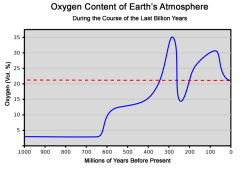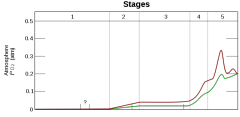A major rainfall led to the buildup of a vast ocean, enriching the other agents, first carbon dioxide and later nitrogen and inert gases. A major part of carbon dioxide exhalations were soon dissolved in water and built up carbonaceous sediments.
Second atmosphere
Water related
sediments have been found dating from as early as 3.8 billion years ago.
About 3.4 billion years ago, nitrogen was the major part of the then stable
"second atmosphere." An influence of life has to be taken into account
rather soon in the history of the atmosphere, since hints of early life
forms are to be found as early as 3.5 billion years ago. The fact that
this is not perfectly in line with the - compared to today 30% lower - solar
radiance of the early Sun has been described as the "Faint
young Sun paradox".
The
geological record however shows a continually relatively warm surface during
the complete early temperature record of the Earth with the exception of one
cold glacial phase about 2.4 billion years ago. Sometime during the late
Archaean era an oxygen-containing atmosphere
began to develop, apparently from photosynthesizing algae which have been
found as stromatolite fossils from 2.7 billion years ago.
The Great Oxygenation Event (GOE, also called the oxygen catastrophe or oxygen crisis or free oxygen (O2) in Earth's atmosphere. This major environmental change happened around .
Photosynthesis was producing oxygen both before and after the GOE. The difference was that before the GOE, rocks chemically captured any free oxygen. The GOE was the point when these minerals became saturated and could not capture any more oxygen. The excess free oxygen accumulated in the atmosphere. The amount of oxygen in the atmosphere has fluctuated ever since.
The most widely accepted chronology of the Great Oxygenation Event suggests that oxygen began to be produced by photosynthesis by organisms (prokaryotic, then eukaryotic) that emitted oxygen as a waste product. These organisms lived long before the GOE, perhaps as early as . The oxygen they produced would have quickly been removed from the atmosphere by the weathering of reduced minerals, most notably iron. This 'mass rusting' led to the deposition of banded iron formations. Oxygen only began to persist in the atmosphere in small quantities shortly (~50 million years) before the start of the GOE. Without a draw-down, oxygen can accumulate very rapidly: at today's rates of photosynthesis (which are admittedly much greater than those in the plant-free Precambrian), modern atmospheric O2 levels could be produced in around 2,000 years.
Another theory is that there is another interpretation of the supposed oxygen indicator, mass-independent fractionation of sulfur isotopes, used in previous studies, and that oxygen producers did not evolve until right before the major rise in atmospheric oxygen concentration. This theory would eliminate the need to explain a lag in time between the evolution of oxyphotosynthetic microbes and the rise in oxygen.
This transforming change also provided a new opportunity for biological diversification, as well as tremendous changes in the nature of chemical interactions between rocks, sand, clay, and other geological substrates and the Earth's air, oceans, and other surface waters. Despite natural recycling of organic matter, life had remained energetically limited until the widespread availability of oxygen. This breakthrough in metabolic evolution greatly increased the free energy supply to living organisms, having a truly global environmental impact; mitochondria evolved after the GOE.
Third atmosphere
The accretion of continents about 3.5 billion years ago added plate tectonics, constantly rearranging the continents and also shaping long-term climate evolution by allowing the transfer of carbon dioxide to large land-based carbonate storages. Measurable amounts of free oxygen did not exist until about 1.7 billion years ago and this can be seen with the development of the red beds and the end of the banded iron formations. This signifies a shift from a reducing atmosphere to an oxidising atmosphere.
O2 showed major ups and downs until reaching a steady state of more than 15%. The following time span was the Phanerozoic era, during which oxygen-breathing metazoan life forms began to appear.
An oxygen-rich atmosphere had two principal advantages for life. Organisms not using oxygen for their metabolism, such as anaerobe bacteria, base their metabolism on fermentation. The abundance of oxygen makes respiration possible, a much more effective energy source for life tha fermentation. The second advantage of an oxygen-rich atmosphere is that oxygen forms ozone in the higher atmosphere, causing the emergence of the Earth's ozone layer. The ozone layer protects the Earth's surface from ultraviolet radiation, which is harmful for life. Without the ozone layer, the development of more complex life later on would probably have been impossible.
The natural evolution of the Sun made it progressively more luminous during the Archaean and Proterozoic eons; the Sun's luminosity increases 6% every billion years. As a result, the Earth began to receive more heat from the Sun in the Proterozoic eon. However, the Earth did not get warmer. Instead, the geological record seems to suggest it cooled dramatically during the early Proterozoic. Glacial deposits found in all cratons show that about 2.3 Ga, the Earth underwent its first big ice age (the Makganyene ice age). Some scientists suggest this and following Proterozoic ice ages were so severe that the planet was totally frozen over from the poles to the equator, a hypothesis called Snowball Earth. Not all geologists agree with this scenario and older, Archaean ice ages have been postulated, but the ice age 2.3 Ga is the first such event for which the evidence is widely accepted.
The ice age around 2.3 Ga could have been directly caused by the increased oxygen concentration in the atmosphere, which caused the decrease of methane (CH4) in the atmosphere. Methane is a strong greenhouse gas, but with oxygen it reacts to form CO2, a less effective greenhouse gas. When free oxygen became available in the atmosphere, the concentration of methane could have decreased dramatically, enough to counter the effect of the increasing heat flow from the Sun.
Life
It is not known when life originated, but carbon in 3.8 billion year old rocks from islands off western Greenland may be of organic origin. Well-preserved bacteria older than 3.46 billion years have been found in Western Australia. Probable fossils 100 million years older have been found in the same area. There is a fairly solid record of bacterial life throughout the remainder of the Precambrian.
Excepting a few contested reports of much older forms from USA and India, the first complex multicelled life forms seem to have appeared roughly 600 Ma. A quite diverse collection of soft-bodied forms is known from a variety of locations worldwide between 542 and 600 Ma. These are referred to as Ediacaran or Vendian biota. Hard-shelled creatures appeared toward the end of that timespan.
A very
diverse collection of forms appeared around 544 Ma, starting in the latest
Precambrian with a poorly understood
small shelly fauna and ending in the very
early Cambrian with a very diverse, and quite modern
Burgess fauna, the rapid radiation of forms
called the
Cambrian explosion of life.

Oxygen Content of the Earth's Atmosphere over the last billion
years
Theological Perspective
By far the biggest issue during the Precambrian has to be the beginning of life. Atheist scientists are trying to show that life can begin on its own, without any help from God. At the same time, young earth creationists are arguing that the earth is only 6,000 years old, and life began when God created it. From the old earth creationist perspective, we believe that God created life in the order that we find it in the fossil record, starting with simple life forms, and progressing to more complex ones throughout earth's history. There are two ways to view the creation of life forms:
1. Theistic Evolution: God created the first life forms, and then they evolved over the billions of years of earth's history. Some people believe that after creating the first life form, God did nothing else, and simply let the physical laws that He put in place run their course. Others believe that God actively guided the evolutionary process.
2. Progressive Creation: God created each and every life form as a unique creation. They did not evolve from previously existing life forms.
Old earth creationists are equally divided among these two beliefs. Which should you believe? That is something that you should discuss with your parents.
How is this reconciled with the events portrayed on each of the six days of creation? For example, on day three, all the plants were created, before day four, which is the creation of the seasons (which many plants depend on), and before all the animals were created on days five and six. However, the fossil record shows new plant species appearing throughout the same time that new animals were being created. The only way to reconcile this is with Creation Overlap. This simply states that God used the six days of creation to explain six events or group of events, some of which overlapped each other. For additional reading on this, see the explanation of Genesis 1 from an old earth creationist perspective (optional reading).
End of Reading
Return to the Old Earth Ministries Online Earth History Curriculum homepage.
Source: Earth's Atmosphere
